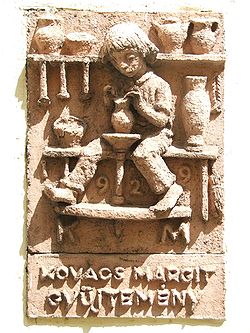
Margit Kovács
Encyclopedia
Margit Kovács was a Hungarian
ceramist and sculptress.
 Margit Kovács was born in Győr
Margit Kovács was born in Győr
, Hungary
on 30 November 1902. She originally wished to become a graphic artist but she grew interested in ceramics in the 1920s and went to study in Vienna with Hertha Bücher, a famous Austrian ceramic artist, from 1926-1928. Then she studied clay modelling in Munich at the State School of Applied Arts under Karl Killer (1928-29). She a was fellow student here, then life-long friend of Julia Bathory
, glass artist. She studied in Copenhagen in 1932 and in 1933 she was at the Sèvres Porcelain
factory where she mastered the art of modelling with chamotte clay to make figures.
Her first public exhibition was in Budapest in 1928 and from then on her output was prolific and she continued working throughout the Second World War. She produced statuettes, pots, plates, wall plaques and tiled murals.
Her main themes are country folk, family life and bible stories. Her work is very varied but is characterised by flowing lines which curve sensually to evoke sentiment. One of her most significant works of religious art are the portals of the Saint Emeric Church of Győr (1939-1940).
In 1972 she donated the majority of her work to the Pest County Museums Directorate in Szentendre
. A museum of her work was opened in 1973 in Vastagh Street, Szentendre.
Kovács died in Budapest on 4 June 1977. Her grave is in Farkasréti Cemetery
in Budapest.
Hungary
Hungary , officially the Republic of Hungary , is a landlocked country in Central Europe. It is situated in the Carpathian Basin and is bordered by Slovakia to the north, Ukraine and Romania to the east, Serbia and Croatia to the south, Slovenia to the southwest and Austria to the west. The...
ceramist and sculptress.
Biography

Gyor
-Climate:-Main sights:The ancient core of the city is Káptalan Hill at the confluence of three rivers: the Danube, Rába and Rábca. Püspökvár, the residence of Győr’s bishops can be easily recognised by its incomplete tower. Győr’s oldest buildings are the 13th-century dwelling tower and the...
, Hungary
Hungary
Hungary , officially the Republic of Hungary , is a landlocked country in Central Europe. It is situated in the Carpathian Basin and is bordered by Slovakia to the north, Ukraine and Romania to the east, Serbia and Croatia to the south, Slovenia to the southwest and Austria to the west. The...
on 30 November 1902. She originally wished to become a graphic artist but she grew interested in ceramics in the 1920s and went to study in Vienna with Hertha Bücher, a famous Austrian ceramic artist, from 1926-1928. Then she studied clay modelling in Munich at the State School of Applied Arts under Karl Killer (1928-29). She a was fellow student here, then life-long friend of Julia Bathory
Julia Bathory
Júlia Báthory was a Hungarian glass designer.Júlia Báthory was born in 1901 in Budapest into an aristocratic family. She pursued her high school studies in Debrecen and Budapest...
, glass artist. She studied in Copenhagen in 1932 and in 1933 she was at the Sèvres Porcelain
Manufacture nationale de Sèvres
The manufacture nationale de Sèvres is a Frit porcelain porcelain tendre factory at Sèvres, France. Formerly a royal, then an imperial factory, the facility is now run by the Ministry of Culture.-Brief history:...
factory where she mastered the art of modelling with chamotte clay to make figures.
Her first public exhibition was in Budapest in 1928 and from then on her output was prolific and she continued working throughout the Second World War. She produced statuettes, pots, plates, wall plaques and tiled murals.
Her main themes are country folk, family life and bible stories. Her work is very varied but is characterised by flowing lines which curve sensually to evoke sentiment. One of her most significant works of religious art are the portals of the Saint Emeric Church of Győr (1939-1940).
In 1972 she donated the majority of her work to the Pest County Museums Directorate in Szentendre
Szentendre
Szentendre is a riverside town in Pest county, Hungary, near the capital city Budapest. It is known for its museums , galleries, and artists. Due to its picturesque appearance and easy rail and river access, it has become a popular destination for tourists staying in Budapest...
. A museum of her work was opened in 1973 in Vastagh Street, Szentendre.
Kovács died in Budapest on 4 June 1977. Her grave is in Farkasréti Cemetery
Farkasréti Cemetery
Farkasréti Cemetery or Farkasrét Cemetery is one of the most famous cemeteries in Budapest. It was opened in 1894 and is noted for its spectacular sight towards the city ....
in Budapest.
External links
- The Kovács museum: http://www.museum.hu/museum/index_en.php?ID=507
- Fine Art in Hungary: http://www.hung-art.hu/frames-e.html?/english/k/kovacs_m/index.html
- International Art Portal: http://www.artportal.hu/international/english/kovacs_margit

